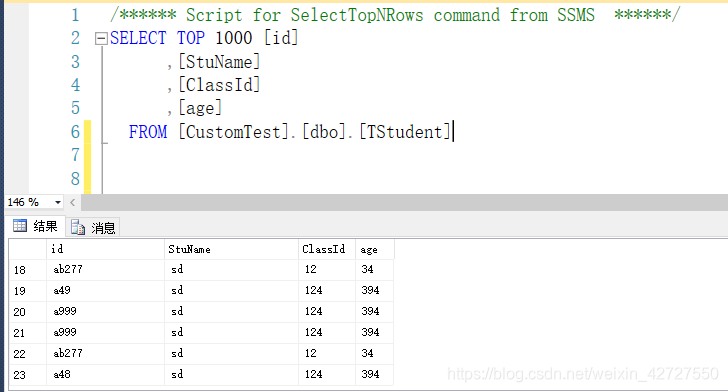文章目录
前言说明
- 本文采用的odbc方式进行
- 本文采用matlab类的形式,也可以自行用面向过程的思想,编写函数。封装为类,仅仅为了方便调用。
Sqlserver数据库表设计

封装类 DBHelperForMatlab类
在matlab中新建DBHelperForMatlab类,这里仅写了插入数据函数。
- 所有需要插入数据库时候,统一调用该代码。在数据库账户变更后,
只需要改变本类,不需要改变其他代码。当然,单独写个函数文件,也是可行的。 - 与matlab自带的insert.m函数相比,封装后,会有返回值,提示保存是否成功等。由于
insert.m函数本身并没有返回值,这是当调通insert函数后,默认cherub数据成功。 - 直接调用该类的方法,用户不用每次都要写关闭数据库连接事件。
-
不足matlab 类效率低,一致被人诟病;尤其在循环调用时,这个可以亲自测试
具体代码如下:
classdef DBHelperForMatlab
% DBHelperForMatlab 用matlab通过odbc方式建立的数据库操作帮助类
% 参考 odbc方式数据库操作 https://blog.csdn.net/cxrsdn/article/details/82632863
% 参考 Matlab面向对象编程实例 https://blog.csdn.net/miscclp/article/details/26090137
% 参考 matlab规范 https://blog.csdn.net/qq_15971883/article/details/82884353
% 参考odbc的详细配置方式 https://www.bbsmax.com/A/MAzAvjreJ9/
properties (GetAccess ='private',SetAccess ='private') %设置私有变量,不能被该类外访问
datasource= 'CustomTest'; %前面设置的数据源名称(实际上应该是封装了访问数据所在电脑的ip地址以及数据库名称),告诉matlab要访问操作的数据库位于哪台计算机(ip地址)中的那个数据库;
userName='s22222a'; %数据库用户账户
password ='13344444446'; %登录密码
end
methods (Static)
% DBHelperForMatlab 显式定义构造函数
function obj=DBHelperForMatlab()
end
% InsertDB 将数据插入到数据库表中
%tableName 数据库表名
%colnames 数据库列名(字段)
%data 与数据库列名相对应的数据,注意数据格式要和数据库中的字段类型类似;数值类型,字符类型
% 返回值 -1:数据库连接失败,没有打开数据库。 1:数据插入成功
function exeState = InsertDB(tableName,colnames,data)
obj=DBHelperForMatlab();
%CanOPen 判断是否成功打开数据库链接,成功返回1,失败返回0
connection=database( obj.datasource,obj.userName,obj.password);
openState=isopen(connection);
if openState==0
exeState=-1; %-1表示没有打开数据库。
else
% https://ww2.mathworks.cn/help/database/ug/database.odbc.connection.execute.html
insert(connection,tableName,colnames,data);
commit(connection); % 将更新保存到数据库中
exeState=1; % 1 成功将数据插入到数据库。
end
close(connection);
end
end
end
调用 DBHelperForMatlab类,插入数据库
function result=testFun()
% testFun 测试封装的插入数据库函数
arr={'id','StuName','ClassId','age'}; %表中的字段,前2个字段是字符型,后2个字段是数值型
da={'f999','sd', 124,394}; %前2个字段是字符型,后2个字段是数值型 ;如果字段类型都是数值,也可以用矩阵等形式做参数,如 da=[12 3 4]
result = DBHelperForMatlab.InsertDB( '[CustomTest].[dbo].TStudent', arr,da) %如果有多行数据需要插入,可以循环调用。
end
matlab中的databasetool中的insert.m函数的部分注释
function insert( connect,tableName,fieldNames,data )
%INSERT Export MATLAB data into database table.
% INSERT(CONNECT,TABLENAME,FIELDNAMES,DATA).
% CONNECT is an object of type database.ODBCConnection, FIELDNAMES
% is a cell array of database column names, TABLENAME is the
% database table and DATA is a cell array, numeric matrix,
% structure, dataset, or table.
%
% If DATA is a structure, dataset, or table, it needs to be formatted in
% a certain way. Each field in the structure or each variable in the
% dataset or table must be a cell array or double vector of size m*1
% where m is the number of rows to be inserted.
%
% Example:
%
% The following INSERT command inserts the contents of
% the cell array in to the database table yearlySales
% for the columns defined in the cell array colNames.
%
% insert(conn,'yearlySales', colNames, monthlyTotals);
%
% where, the cell array colNames contains the value:
% colNames = {'salesTotal'};
%
% 'monthlyTotals' is a cell array containing the data to be
% inserted into the database table 'yearlySales'
%
% See also connection/datainsert, connection/fastinsert
% Copyright 1984-2016 The MathWorks, Inc.
% 山南编辑,补充部分中文翻译。2019年8月20日18:12:53
% Check for valid connection
if(~isopen(connect))
% shannan汉化 error(message('database:database:invalidConnection'));
error(message('连接数据库失败!'));
end
%Input validation
p = inputParser;
p.addRequired('tableName', @database.internal.utilities.DatabaseUtils.tablenameCheck);
p.addRequired('fieldNames', @database.internal.utilities.DatabaseUtils.fieldnamesCheck);
p.addRequired('data', @database.internal.utilities.DatabaseUtils.insertDataCheck);
%Catch Input Validation errors
p.parse(tableName,fieldNames,data);
tablename = char(p.Results.tableName);
fieldNames = cellstr(p.Results.fieldNames);
data = p.Results.data;
%Get size of data
switch class(data)
case {'int8','uint8','int16','uint16','uint32','int32','int64','uint64','single'}
data = double(data);
numberOfCols = size(data,2);
if numberOfCols ~= length(fieldNames)
error(message('database:insert:numerofColumnsMismatch'))
end
case {'cell','double'}
numberOfCols = size(data,2);
if numberOfCols ~= length(fieldNames)
error(message('database:insert:numerofColumnsMismatch'))
end
case 'struct'
sflds = fieldnames(data);
if length(sflds) ~= length(fieldNames)
error(message('database:insert:numerofColumnsMismatch'))
end
fchk = setxor(sflds,fieldNames);
if ~isempty(fchk)
error(message('database:insert:fieldMismatch','Structure fields'))
end
% order of columnnames and struct variable names should match
for i=1:length(fieldNames)
if strcmpi(sflds{i}, fieldNames{i}) == 0
error(message('database:insert:fieldMismatch','Structure fields'))
end
end
numberOfCols = length(sflds);
data = database.internal.utilities.DatabaseUtils.validateStruct(data);
case 'dataset'
dSummary = summary(data);
sflds = {dSummary.Variables.Name};
fchk = setxor(sflds,fieldNames);
if ~isempty(fchk)
error(message('database:insert:fieldMismatch','Dataset variables'))
end
% order of columnnames and struct variable names should match
for i=1:length(fieldNames)
if strcmpi(sflds{i}, fieldNames{i}) == 0
error(message('database:insert:fieldMismatch','Dataset variables'))
end
end
numberOfCols = length(sflds);
%convert dataset to struct before pushing to the C API
data = dataset2struct(data, 'AsScalar', true);
data = database.internal.utilities.DatabaseUtils.validateStruct(data);
case 'table'
sflds = data.Properties.VariableNames;
if length(sflds) ~= length(fieldNames)
error(message('database:insert:numerofColumnsMismatch'))
end
fchk = setxor(sflds,fieldNames);
if ~isempty(fchk)
error(message('database:insert:fieldMismatch','Table variables'))
end
% order of columnnames and struct variable names should match
for i=1:length(fieldNames)
if strcmpi(sflds{i}, fieldNames{i}) == 0
error(message('database:insert:fieldMismatch','Table variables'))
end
end
numberOfCols = length(sflds);
%convert table to struct before pushing to the C API
data = table2struct(data, 'ToScalar',true);
data = database.internal.utilities.DatabaseUtils.validateStruct(data);
otherwise
error(message('database:insert:inputDataError'))
end
% Create INSERT query to be prepared.
fieldNamesString = '';
parameterString = '';
% Create the field name string for the INSERT statement .. this defines the
% fields in the database table that will be receive data.
% Also build variable ?'s string for later set* commands
% 根据用户传入的表名、列字段 拼接成 标准SQL语句 insert [TStudent](id,StuName,ClassId,age) values (?,?,?,?)
% 注意该标准SQL语句并没有赋值,而是用?代替
for i=1:numberOfCols
if ( i == numberOfCols)
fieldNamesString = [ fieldNamesString fieldNames{i}]; %#ok
parameterString = [parameterString '?)']; %#ok
else
fieldNamesString = [ fieldNamesString fieldNames{i} ',' ]; %#ok
parameterString = [parameterString '?,']; %#ok
end
end
try
%Get Database Product name
dbProdName = connect.DatabaseProductName;
validDB = 0;
if strcmpi(dbProdName, 'Oracle') || strcmpi(dbProdName, 'PostgreSQL') || strcmpi(dbProdName, 'Microsoft SQL Server')
validDB = 1;
end
if validDB
transactionStmt = connect.Handle.createStatement;
% Save the current setting and turn off auto-commit
oldState = connect.AutoCommit;
connect.AutoCommit = 'off';
end
%Using the faster ODBC API method for MySQL
if(strcmpi(dbProdName, 'MySQL') || strcmpi(dbProdName, 'Access'))
%Create SELECT string
selectString = ['select ' fieldNamesString ' from ' tablename ' where 1=2'];
%Create new statement for INSERT
insertStmt = connect.Handle.createStatement;
insertStmt.insertData(dbProdName, selectString, data);
%close both statements
insertStmt.closeStatement;
else
% Create the SQL statement
parameterizedInsertString = [ 'INSERT INTO ' tablename ' (' fieldNamesString ') ' 'VALUES ( ' parameterString ];
%Need to run exec query to get column attributes
curs = exec(connect,['select ' fieldNamesString ' from ' tablename ' where 1=2']);
if ~isempty(curs.Message)
error(message('database:insert:insertError', curs.Message))
end
curs = fetch(curs, 1);
if ~isempty(curs.Message)
error(message('database:insert:insertError', curs.Message))
end
%Create new statement for INSERT
insertStmt = connect.Handle.createStatement;
% 完整的数据库赋值语句是下面这句。 data是数据库表各字段所对应的具体值
insertStmt.insertData(curs.Statement,parameterizedInsertString, data);
%close both statements
insertStmt.closeStatement;
close(curs);
end
% close transaction stmt
if validDB
if strcmpi(oldState, 'on')
% Commit changes
transactionStmt.executeQuery('COMMIT');
end
% Close the transaction statement
transactionStmt.closeStatement;
% Reset auto-commit to original value
connect.AutoCommit = oldState;
end
catch e
%close statements and then throw error
if(exist('curs', 'var'))
close(curs);
end
if(exist('insertStmt', 'var'))
insertStmt.closeStatement;
end
if validDB
if strcmpi(oldState, 'on')
% Rollback changes in case of failures
transactionStmt.executeQuery('ROLLBACK');
end
% Close the transaction statement
transactionStmt.closeStatement;
% Reset auto-commit to original value
connect.AutoCommit = oldState;
end
% Reset auto-commit to original value
throw(e);
end
end
























 1211
1211

 被折叠的 条评论
为什么被折叠?
被折叠的 条评论
为什么被折叠?








